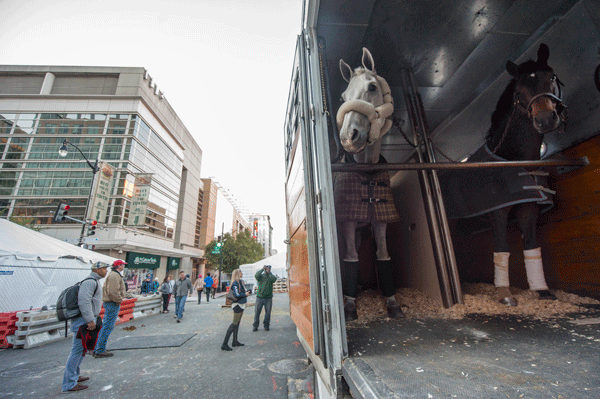Traveling domestically or abroad and importing horses from afar is part and parcel of a professional rider’s life. Figuring out how best to protect him or herself from the additional risks that accompany that reality is a big challenge. In this article, top riders tell how they insure their own and their clients’ horses and provide a few tips for those with more common insurance requirements.

No matter the circumstances, the pros I spoke with all recommended the basics: Be confident in your insurance agent and the company he or she represents and take time to fully understand what the proposed policy will and will not cover in various situations.
As the show season winds down each fall, Amy Ebeling turns her attention to the annual renewal of equine insurance policies for the horses at The Acres, the Moorpark, California, training base for her and her husband, Olympian Jan Ebeling. It’s a big task involving some valuable horses, including Jan’s 2012 Olympic Games mount, Rafalca, and Rassolini, the 10-year-old World Equestrian Games hopeful purchased this past spring.
The Acres insures most of its horses with mortality policies plus additional major medical and accidental loss-of-use coverage. “Accidental” loss of use differs from “full” loss of use in that it covers incidents that occur from an external, accidental and sudden incident, Amy explains: a trailering accident or a misstep in the arena, for example. It does not cover wear and tear injuries.
Loss-of-use insurance comes into play if a horse is permanently unable to do his job. So it’s critical that a horse’s job description is carefully spelled out when applying for and buying such coverage. “It’s important to designate the use of the horse as a dressage competition horse,” Amy notes. “Otherwise, there could be confusion with an insurance company being able to say that the horse, if it’s a mare or stallion, could be used for breeding.”
The Ebelings extend the policies to cover Jan’s horses when they are in transit to and from and competing outside the United States and Canada. The additional cost for protection while outside the policy’s normal territory is a percentage—between .25 and .5 percent—of the horse’s agreed-upon value. It’s expensive, Amy acknowledges, but worth it for the peace of mind and the financial protection.
When Rafalca first won a USEF travel grant in 2007 she injured herself after an awkward move while training in Germany. “She jumped straight up and came down on all four legs,” Amy recounts. “The next morning, she could not walk from her stall to the grooming area.”
The mare had fractured a tiny bone in her upper leg, a painful but fortunately minor injury that healed relatively fast. The major medical policy covered veterinary care, lay-up and rehab costs incurred during her roughly 60-day return to form.
To control costs somewhat, The Acres typically insures its horses for something less than their full market value. They “self-insure” by setting aside funds to handle any gaps in what their insurance policies provide.
Grand Prix competitor and trainer Caroline Roffman maintains mortality and major medical policies on her show horses, including her Grand Prix veteran Sagacious HF and her new entry, Her Highness O. Caroline carries extensions to cover out-of-territory travel and competition, as she did to and through Europe last summer on her tour that included the Aachen CDI Under-25 Freestyle (in which she finished second).
“It was so comforting to know that in the stressful time of shipping the horses were covered,” Caroline says. She avoids loss-of-use insurance and advises those who choose it to read their policies carefully. “What happens if you have a $100,000 FEI horse that is no longer able to perform at FEI levels because of a career-ending injury but perhaps could do the lower levels? Then what?”
Caroline recommends that her clients at Lionshare Dressage in Palm Beach Point, Florida, secure coverage for their horses “from the moment of purchase. And especially so when the horse has a long trip ahead of him, be it across the country or the world.”
Grand Prix competitor Catherine Haddad-Staller spent 20 years in Germany before returning to the United States in 2012, when she established stables in Oldwick, New Jersey, and Wellington, Florida. She adds liability insurance when showing in Europe. “European venues—shows, riding stables, et cetera—require that your horse be insured for liability in case he causes damage to people or property.”
Cindi Wylie’s belief in the importance of insuring horses in transit has been validated on numerous occasions. “We had two horses loaded onto a plane and then unloaded due to the eruption of the volcano in Iceland,” recounts the Grand Prix rider and trainer based at Quarterline Dressage at Rosebrook Farm in Georgetown, Massachussets. “While our horses’ welfare is always first and foremost, our investors had a significant amount invested in those two. The horses were stuck in transit for almost two weeks, and it was a relief to know our investors were covered.”
It cost $125 per horse per trip for that in-transit coverage and was more than worth it. And, happily, both horses made it out just fine.
No matter where her horses are, insurance has been a wise decision for Cindi. “We had one medical issue with one horse that would have cost us $11,000, but the costs were covered by medical insurance in the end.
“Owning top dressage horses is not an inexpensive proposition,” she continues. “But knowing your investment is secure and that large medical bills will be covered helps take some of the angst out of it. The big key is having an insurance agent, vet and company that know horses and are realistic about the coverage.”











